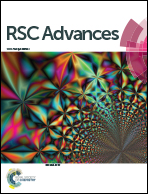Controllable high-throughput fabrication of porous gold nanorods driven by Rayleigh instability†
Abstract
Nanoporous gold (NPG) nanorods have recently attracted tremendous interest and research effort due to their vast applications in biomedical engineering, catalysis and photonics areas. However, the rational fabrication of large volumes of low-aspect-ratio NPG nanoparticles with well-defined geometries remains a difficult challenge. Here we demonstrate a controllable fabrication of porous gold nanorods by a novel template-assisted electrodeposition and in situ fragmentation of Au–Ag alloy nanowires, followed by a dealloying process to convert the resulting Au–Ag nanorods into desired NPG nanorods. The thermal-induced fragmentation process was believed to be associated with Rayleigh instability of the alloy nanowires confined within anodic aluminum oxide (AAO) templates, which has been further confirmed by in situ TEM experiments for geometrically confined gold nanowires upon Joule heating. More importantly, the status of the nanowire-breakdown process can be monitored in situ by macroscopic current–voltage (I–V) measurements of the over-grown nanowires–AAO sandwich structure. Together with a one-step dealloying finishing process, our method could facilitate the mass production of high quality NPG nanorods with well-controlled diameters, which could open up many opportunities for low-cost, high-throughput fabrication of low-aspect-ratio porous metallic nanorods for biomedical (such as drug delivery) and other applications.


 Please wait while we load your content...
Please wait while we load your content...